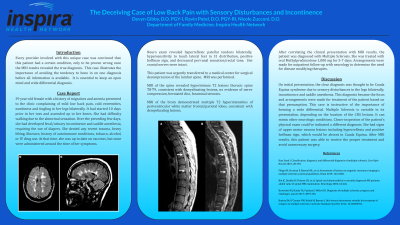Back

Clinical: General Topics
The case of low back pain with sensory disturbances and incontinence that deceived everyone.
Friday, March 31, 2023
12:00 PM East Coast USA Time


Devyn J. Gibby, DO
Resident
Inspira Health Network
Sicklerville, New Jersey, United States
Presenting Author(s)
Introduction: Every provider involved with this unique case was convinced that this patient had a certain condition, only to be proven wrong once the MRI results revealed the true diagnosis. This case illustrates the importance of avoiding the tendency to hone in on one diagnosis before all information is available. It is essential to keep an open mind and wide differential diagnosis.
Case Study: 39 year-old female with a history of migraines and anemia presented to the clinic complaining of mild low back pain, cold extremities, numbness and tingling in her legs bilaterally. It started 10 days prior in her toes and ascended up to her knees. She has difficulty walking due to the abnormal sensation. Over the past few days, she developed fecal/urinary incontinence, requiring the use of diapers. Endorses saddle anesthesia. She denies recent trauma, heavy lifting, illnesses, history of autoimmune conditions. She is up to date on vaccines, but none were recently administered. Denies tobacco, alcohol, and IV drug use.
Neuro exam: hyperreflexic patellar tendons bilaterally, hypersensitivity to touch lateral feet in S1 distribution, positive hoffman sign, decreased perianal sensation/rectal tone, cranial nerves intact.
This patient was urgently transferred to a medical center for surgical decompression of the lumbar spine. MRI was performed.
Hyperintense T2 lesion thoracic spine T8-T9, consistent with demyelinating lesion, no evidence of nerve compression, herniated disc, foraminal stenosis.
Multiple T2 hyperintensities of periventricular white matter frontal/parietal lobes, consistent with demyelinating lesions.
After correlating the clinical presentation with MRI results, the patient was diagnosed with Multiple Sclerosis. She was treated with oral Methylprednisolone 1000mg for 5-7 days. Arrangements were made for outpatient follow-up with neurology to determine the need for disease modifying therapies.
Discussion: On initial presentation, the clear diagnosis was thought to be Cauda Equina syndrome due to sensory disturbances in the legs bilaterally, incontinence and saddle anesthesia. This diagnosis became the focus and arrangements were made for treatment of the patient based on that presumption. This case is instructive of the importance of forming a wide differential. Multiple Sclerosis is variable in its presentation, depending on the location of the CNS lesions. It can mimic other neurologic conditions. Closer inspection of the patients' exam could've indicated a different diagnosis. She had signs of upper motor neuron lesions including hyperreflexia and positive hoffman sign, which would be absent in Cauda Equina. After MRI results, this patient was able to receive the proper treatment and avoid unnecessary surgery.
Case Study: 39 year-old female with a history of migraines and anemia presented to the clinic complaining of mild low back pain, cold extremities, numbness and tingling in her legs bilaterally. It started 10 days prior in her toes and ascended up to her knees. She has difficulty walking due to the abnormal sensation. Over the past few days, she developed fecal/urinary incontinence, requiring the use of diapers. Endorses saddle anesthesia. She denies recent trauma, heavy lifting, illnesses, history of autoimmune conditions. She is up to date on vaccines, but none were recently administered. Denies tobacco, alcohol, and IV drug use.
Neuro exam: hyperreflexic patellar tendons bilaterally, hypersensitivity to touch lateral feet in S1 distribution, positive hoffman sign, decreased perianal sensation/rectal tone, cranial nerves intact.
This patient was urgently transferred to a medical center for surgical decompression of the lumbar spine. MRI was performed.
Hyperintense T2 lesion thoracic spine T8-T9, consistent with demyelinating lesion, no evidence of nerve compression, herniated disc, foraminal stenosis.
Multiple T2 hyperintensities of periventricular white matter frontal/parietal lobes, consistent with demyelinating lesions.
After correlating the clinical presentation with MRI results, the patient was diagnosed with Multiple Sclerosis. She was treated with oral Methylprednisolone 1000mg for 5-7 days. Arrangements were made for outpatient follow-up with neurology to determine the need for disease modifying therapies.
Discussion: On initial presentation, the clear diagnosis was thought to be Cauda Equina syndrome due to sensory disturbances in the legs bilaterally, incontinence and saddle anesthesia. This diagnosis became the focus and arrangements were made for treatment of the patient based on that presumption. This case is instructive of the importance of forming a wide differential. Multiple Sclerosis is variable in its presentation, depending on the location of the CNS lesions. It can mimic other neurologic conditions. Closer inspection of the patients' exam could've indicated a different diagnosis. She had signs of upper motor neuron lesions including hyperreflexia and positive hoffman sign, which would be absent in Cauda Equina. After MRI results, this patient was able to receive the proper treatment and avoid unnecessary surgery.
